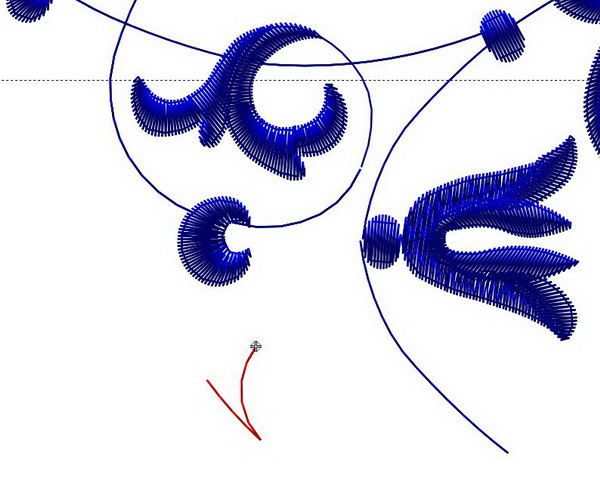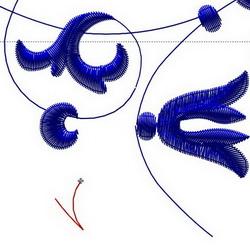Original text by Marina Belova
There were times when lining up the parts of a big design was a sealed book to me. Many lances were broken over this seal. But I'll relate the facts as they actually happened.
For example, even a beginner can align the design on the cem-135 machine. It's all due to its magic ability to rotate the designs by a required angle in accordance with the alignment marks. Which I successfully employed in my first embroidery design. It was no less than a pillow with initials and a wide border along the perimeter.
But after our department got a commercial eight-head embroidery machine, life instantly became complicated.
Everything was difficult, from hooping to the need to hit the right place with a needle. We learned bit by bit, and something the result was satisfactory, sometimes — not at all.
But I really understood how to align machine embroidery designs only after I left to work for the rival company. Then I learned to align the designs on single-head embroidery machines that had small frames. Their biggest frame then allowed to embroider a design about 33х52 cm.
After someone shows you how to do the alignment, all you need is skill and a bit of contemplation. Hats off to my previous employer for having demonstrated me how to create and embroider designs that require rehooping.
You can do miracles on single-head embroidery machines. There image size does not matter — you just split it into however more large pieces and hoop.
The only thing is that embroidering curtains or large tablecloths requires a lot of time and is rather tiresome. But the pull is less in such a small frame. I realized this when I moved to the bigger frame.
The alignment process on single-head machines was described well over ten times:
- Mark the fabric with lines or dots, whichever ones you prefer, to understand, where the embroidery will be located.
- Split the file, leaving alignment marks, which will help you to match the pieces after rehooping. You may encounter alignments crosses, Z-stitches and simple alignment stitches of various shapes. For example, the alignment stitch may look as the red one on the photo below.
- Embroider the first piece of the design
- Rehoop according to the alignment chart so that the alignment stitch was located within the hoop.
- Load the next file.
- First, you stitch the alignment stitch, which, in the case of the correct hooping, should correspond with the alignment stitch in the previous piece.

This is not difficult at all, but requires some skill and practice.
Understanding that I can move mountains on my embroidery machine lifted my spirits, made me feel self-assured and proud of myself. At this very point, my conceit was deflated by the wonderful ZSK embroidery machine.
After having worked for the rival company, I returned to the machine with a devil-may-care attitude. But it turned out that I had yet to cover a lot of ground, starting from the very basic things like using the long frame. The thing is that you should frame the fabric in such a way that it will not be distorted, otherwise, curtains and curtain laces, tablecloths, and the other things like that can go directly into the garbage can.
I learned to hoop about 40 attempts after. Only then I began to "sense" the fabric.
But framing was not the hardest thing of all on this machine. Instead — a strange thing to say — a large number of heads each one covering a very small embroidery area presented the biggest problem.
The small size of the embroidery area demands the need for framing with extreme care in order to align the new part of the embroidery with the previous one so that they match.
There is no 2 or 3 cm allowance for hoop shifting in order to match the alignment stitches here, like on single-head embroidery machines. For there are rapports (that I used to dream of in the past), which are almost of the same width as the embroidery area and therefore cannot be moved. 1-2 mm, maybe, but not more.
In other words, even if the hooping went wrong, I could not move the frame a couple of cm left or right to hit the alignment mark, otherwise the rapports could not be embroidered, for they were 40 cm wide. That's because if I shifted the frame for 2 cm to either side, there would be only 38 left. I cannot even do the outline, for my design will not fit the embroidery area.
And then it dawned upon me, how important it was to plan the future design from the technical standpoint so that it would be easier to align the parts of the complex designs. The technical moments include distributing the embroidery areas between the heads and planning the positioning of the alignment marks prior to the design being created, let alone digitized.
But the more I embroider, the more I understand why all the well-known Western manufacturers do not create such a fuss of the embroidery machines as we do here in Russia. Moreover, they will never make much of those machines that are not fit for embroidering such designs.
Because there are other kinds of equipment for this purpose, and have been for a long time now. Making this kind of embroidery is unprofitable.
For the simple reason of their high cost. You cannot make much money on it.
This is Russian "kitchen-table-effort". This is all just a bravado, an attempt to show that we are all Koulibins or Cross-eyed Leftys from Tula here.
But, how it strength your brain to create such a design!
Read here how to join the parts of a simple design together.
Edited by Irina



There are no reviews to display.